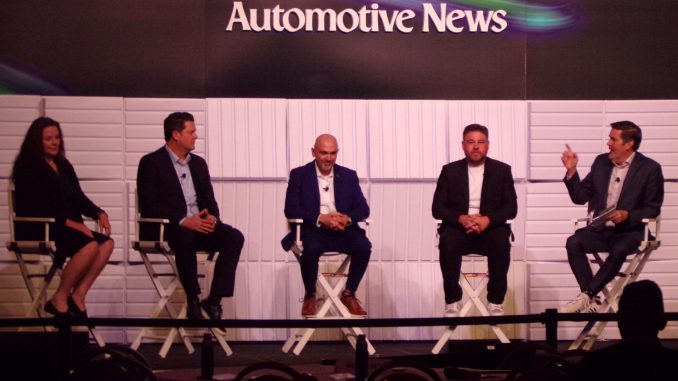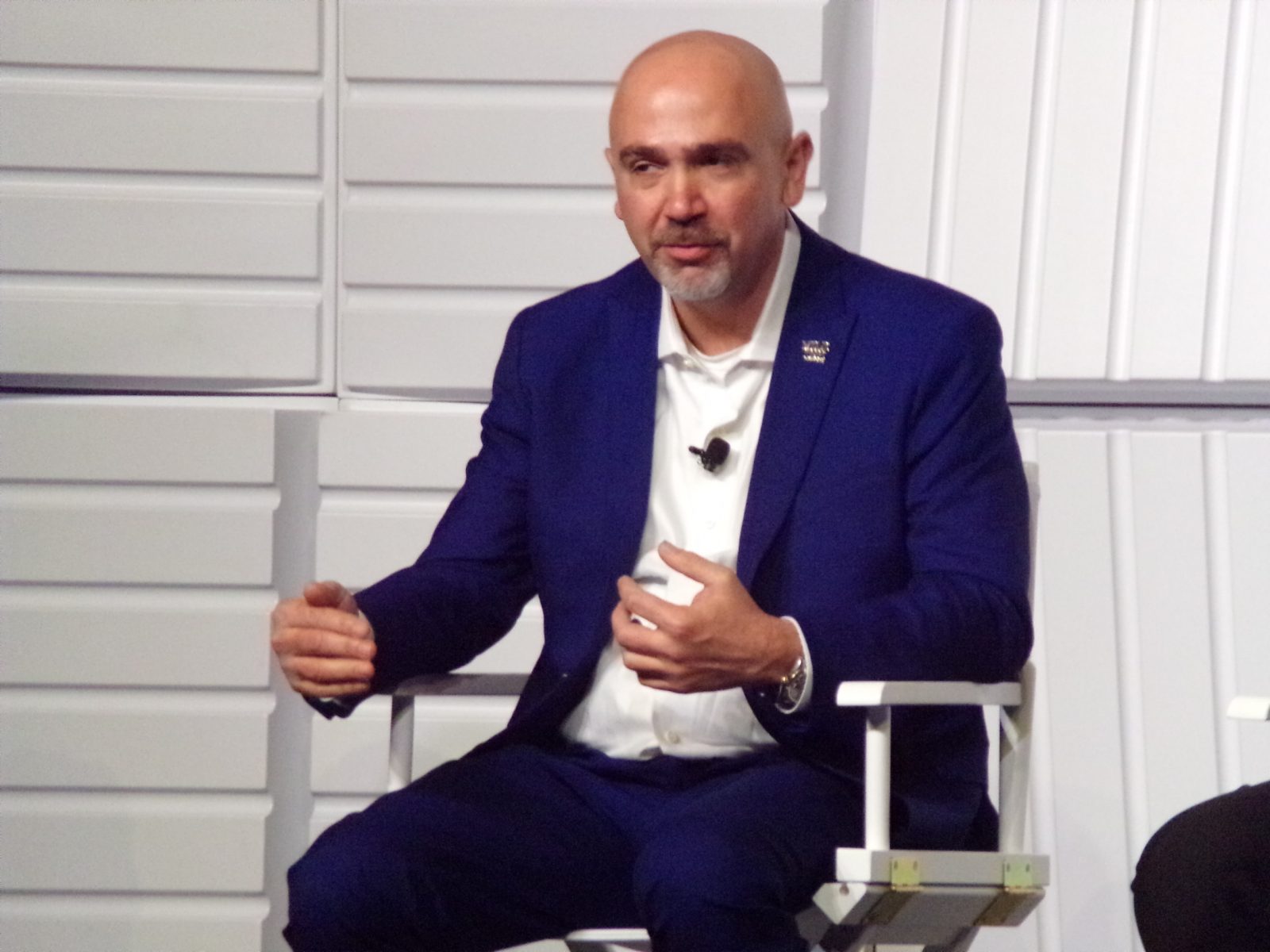
Las Vegas — The automotive industry is in the middle of a massive transition from internal combustion engine vehicles (ICE) to electric vehicles (EVs). Are dealers ready to sell electric vehicles? Are consumers ready to buy them? What about the lack of charging infrastructure?
Those were some of the questions answered at the the 2024 Automotive News Retail Forum. It featured an insightful panel discussion titled “How to Prepare for an Uncertain EV Market.”
Panelists included Eric Watson, VP of Sales Operations at KIA America; Ed Roberts, COO of Bozard Ford-Lincoln; Rick Ricart, President of Ricart Automotive Group; and Melinda Zabritski, head of Automotive Sales Insights at Experian Automotive. Automotive News Senior Editor Dan Shine served as the moderator.
Q: Two years ago, EVs were the buzz at the NADA Show. Everyone was excited about them. Two years later, there is kind of this malaise that has settled. What’s happening?
“I think the adoption pace was a little bit exaggerated,” said Ricart. “I think a lot of manufacturers were very aggressive and wanted to switch over to battery electric vehicles. They’re red hot in the west coast. Where we are in the midwest, there’s a little more hesitation. There’s climate factors, it’s cold. What’s the charging infrastructure? We pictured a lot higher sales in the next three to five years. It is here to stay but it’s a little bit slower.”
Roberts added: “We sell better than 10 (EVs) a month but less than 20. As talked about earlier, the higher earners are usually the early adopters. We told those guys not along ago, in the last year, that they would not get the tax credit anymore. It took those people out of the market for that reason as well. It confused the rest of the consumers with: where’s the battery being sourced from? When you create that confusion, you take it out of their consideration.”
“We’re showing that about 8 percent of sales are EV from a finance standpoint,” said Melinda Zabritski. “There’s still a lot of questions about financing EVs and transparency. I think from a consumer standpoint it’s challenging. If you go online, what’s your exact payment? At least in Colorado, you kind of can’t do that because you might qualify for this credit or this credit. It might be this, it might be that. You just don’t know. Adoption is still relatively low. About 1.7 percent of households have an EV. The average length of ownership is less than three years.”
Eric Watson says KIA’s EV sales were up 57 percent in January when compared to 2023.
“A lot of that was driven…we did start the sale of our EV9. We’ve got a new vehicle that’s breaking into a segment of a family, three-row SUV. I think the industry is kind of in an inflection point. Its doubled in volume over the years. In Colorado, we’re seeing an explosion of growth. They just passed $5,700 state tax credit. We can’t keep EVs in stock in that state right now. We’ve got some dealers that are a little more advanced in pushing EVs in their markets. They’ve got sales people who push it and help people adopt it.”
Q: After three years, how many consumers go back to an internal combustion engine (ICE) vehicle?
“We were looking at length of ownership is like 2.87 years where it’s 13 years for ICE,” Zabritski answered. “It was 43 percent of EV buyers who dispose of their EV go back to an EV. Forty-one percent go back to an ICE.”
Q: What about confusion over the EV tax credits? How big of a factor is that for consumers to jump into to buy an EV?
“Two years ago there was so much extra money in the marketplace,” Ricart answered. “We had consumers buying both ICE and EVs that were the higher priced vehicles we just couldn’t keep in stock, they were red hot. Where the economy is today, really having to budget and look at the numbers, I think the tax credit, if it ran smoothly and was simple to process, they could see over the spike as long as the affordability was equivalent to ICE vehicles. Gas prices really haven’t gone up. When you look at that for total ownership, consumers don’t really want to pay more for battery electric when they don’t need to.”
Ed Roberts explained that consumers who are interested in EVs come to the dealer with a list of questions that they hope to get answered.
“That salesperson would spend most time trying to sell an EV than they would selling an ICE,” Roberts said. “Yet, the EV if we sell it sticker has the least amount of margin, least amount of gross sale, least amount of percentage of commission and he’s going to spend the most time doing it so he doesn’t want to push that EV either. That’s the reality.”
Eric Watson from KIA added: “I have teams of people trying to track who’s eligible for tax credits and what you have to do to qualify for them. I think that amongst the customers that are shopping, I can’t keep track of which brands and models qualify for it. Now they’re saying they’re going to get the sourcing materials and qualify for it in May. I think people are just confused and it stops them from retail shopping. Really it’s a shame because EVs are fantastic vehicles. They’re fun to drive, they’re great quality. KIA’s last two EVs have won North American Utility Vehicle awards. I think once this settles down a little bit, you may see a little more shopping towards EVs. The government has created so much confusion right now that it’s hard for all of us to keep up with it.”
Zabritski said: “I saw a very interesting slide at the finance conference the other day where it had the EV adoption states by political party. The Trump states very low EV adoption. The Biden states very high EV adoption. Based on how the election goes, it could completely change everything for incentives and where the EV market’s going.”
Ricart added: “From a dealer standpoint, anytime you launch a new marketing campaign, it always starts internal. You want the employees and people involved to understand the marketing messages and why. We like to encourage our staff to go out and test drive and take an EV home to make sure that you are creating advocates within. We’ve had to spend a lot of money when it comes to charging across all of our brands. In fact, several of our facility requirements require you to have different level of chargers… so we don’t want to wait five years to get the earn back on all of this money we invested. We have to be able to try to increase marketing ourselves by creative advocates and overcome their objections.”
Watson said: “I think we’ve developed a very robust business strategy to refresh and grow our volume on our ICE vehicles and trying to get incremental growth on EVs. That’s the best we can do now. Continue to prop up our dealers buying profitable ICE vehicles they sell…when there’s more profitability on EVs for everybody, then our dealers will have more volume and have a base to support that transition.”
Roberts said offering test drives in an EV is another challenge.
“You can’t just put a charge in an EV,” he explained. “If it’s not charged, it ain’t going anywhere. We have to do a better job to prepare ourselves by getting the manufacturer and the government to work together to where we don’t have to calculate the incentive. Who gets it and who doesn’t so its refunded in the MSRP.”
Zabritski said that charging infrastructure is another barrier — especially with consumers who live in apartments, condos and other multi-family buildings.
“You have to consider how many households have a garage,” she said. “I’m the only person on my street in my entire neighborhood that parks my car in my garage. Apartments, storage, I have a 120-year-old house. I can’t have an EV, my house would explode. What do these people do? Getting to 30, 40, 50 percent, I’m a little leary about.”
Q: People are buying EVs, maybe not as quickly as we thought. What needs to happen to move the needle to where there’s significant growth?
“I think the next couple of years are going to be a little bit rough,” Watson said. “I think there’s about 40 name plates in the EV market today. Every manufacturer is coming out with multiple models. It’s going to be new segments, more affordable price points. It will draw more people in. You still have political uncertainty, infrastructure uncertainty. At some point in the future, there will be an inflection, right? Cars will be affordable, the infrastructure will come into place, there will be more certainty around government and tax credits. I think we’re in for a rough year or two years with the transition.”
Zabritski added: “New car buyers are not your everyday buyer anyway. New car buyers are your prime consumer, they’ve got financing options. The average credit score for EV buyers is 782. It’s definitely a premium consumer. I’m hearing anecdotally dealers saying, ‘hey, I don’t want to take in a used EV.’ So what happens to the used market?”
Ricart says EVs are depreciating in value much faster than internal combustion engine vehicles or hybrids are.
“There’s a strong lease program to make that affordability equation work,” Ricart explained. “In two to three years from now, EVs will be stronger to get the butts in seats and get these cars on the road. The person who drives 20,000 miles a month isn’t buying an EV anyways. They are lower mileage drivers at least in our market. The other thing that we are patiently waiting on is the battery technology. These lithium ion batteries in the wintertime when it’s 0 degrees out…they can’t charge fast. We’re having an issue with those. There’s technology coming with solid state batteries that have a lot longer range. I think as that progresses also, that’s where consumers will be more comfortable getting into the market. The next couple of years is marketing ourselves, creating the advocates, hoping for strong lease programs and training our people to know that we need to sell these.”
Many early adopters already have their EVs. The challenge will be convincing apartment dwellers and others to buy these vehicles while there are not enough public charging stations available in most metro areas.
The Retail Forum kicked off 2024 NADA Show week in Las Vegas.

Graphic by Urban Science 
Retail BEV Share by County (2023) 
Melinda Zabritski, head of automotive financial insights at Experian Automotive 
Eric Watson, vice president of sales operations at KIA America 
Ed Roberts, COO of Bozard Ford-Lincoln 
Rick Ricart, president of Ricart Automotive Group and Dan Shine, senior editor of Automotive News.
